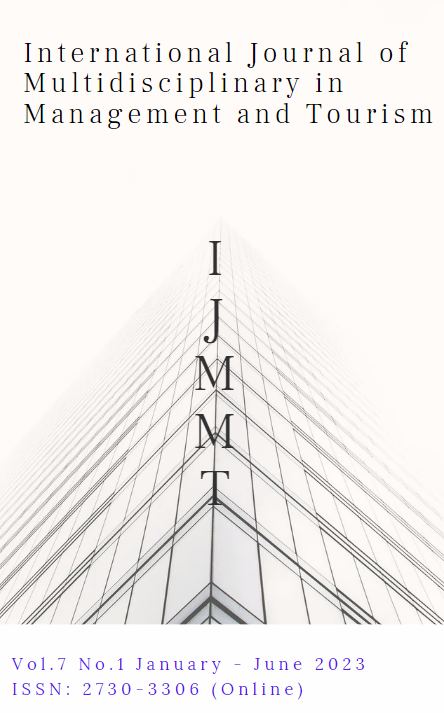The Development of Value Co-creation of New Retail in Taian City, The People's Republic of China
Main Article Content
Abstract
The Internet has become an integral part of people and businesses. Others have adapted by bringing the Internet into use in the organization to increase the efficiency of business operations. This Article aimed to study (1) the difference between Offline and Online retail in theory and approach (2) the development of new retail in TAIAN City (3) the reasons that influence the value co-creation of new retail model in TAIAN City and (4) the directional suggestions for the development of new retail in TAIAN City. It is quantitative and qualitative research; The sample was 400 samples. The questionnaire was used for quantitative research. and qualitative research through in-depth interviews with 20 department managers. The analysis of basic data adopts content such as frequency, percentage, mean, standard deviation, etc. and the second part is model analysis, which uses A-mode structural equation statistical analysis.
The research results were found as follows;
1. Online retail and offline retail have a positive impact on the development of new retail.
2. In the process of development, producers and consumers are no longer competitors, and they use the concept of value co-creation to achieve maximum benefits.
3. Online retail utilizes more efficient communication and convenient services to make consumers feel needed and respected and participate in value co-creation together.
4. Value co-creation serves as an intermediate bridge to promote the development of new retail, actively guiding the integration of online retail and offline retail, and promoting the development of new retail.
It was concluded that in modern retail Online sales and offline sales should be developed in order to be successful and maximize the benefit of all parties. The concept of creating value must be brought together and there must be effective communication in order to provide good service to customers.
Article Details

This work is licensed under a Creative Commons Attribution-NonCommercial-NoDerivatives 4.0 International License.
References
Aziz, N.N.A., & Wahid, N.A. (2018), Factors influencing online purchase intention among university students, International Journal of Academic Research in Business and Social Science, 8(7), 702-777.
Chen, F., & Thoard, M. (2022). The creative approach for promoting violin performing arts in China in the 20th century. International Journal of Multidisciplinary in Management and Tourism, 6(2), 129–138. https://doi.org/10.14456/ijmmt.2022.11
Cochran, W.G. (1977) Sampling techniques. (3rd ed.). John Wiley & Sons.
Daroch, B. (2021). A study on factors limiting online shopping behaviors of Consumers, Rajagiri Management Journal, 15(1), 39-52.
Idowu, M. (2022). Impact of customer value co-creation through the use of self-checkout system in retail stores: qualitative research on a retail store in Sweden. Linnaeus University Press.
Kotler, P. (1997). Marketing management. Prentice Hall.
Lentz, Erik W. (2019). Exotic behaviors of space-time in Einstein-Maxwell theory. General Relativity and Quantum Cosmology. https://doi.org/10.48550/arXiv.1909.00284
Prahalad, C.K., & Krishnan, M.S. (2008. The new age of innovation. McGraw-Hill Professional Publishing.
Ratchford, B. (2022). Online and offline retailing: What we know and directions for future Research. Journal of Retailing, 98, 152-154.
Serirat, S. et al. (2003). New era marketing manager. Thammasarn.
Shang, Y., Chen, X., Liu, W., Tan, P., Chen, H., Wu, L., Ma, C., Xiong, X., & Pan, J. (2017). Photo corrosion inhibition and high-efficiency photoactivity of porous g-C3N4/Ag2CrO4 composites by simple microemulsion-assisted co-precipitation method. Applied Catalysis B: Environmental, 204, 78-88. https://doi.org/10.1016/j.apcatb.2016. 11.025
Silanoi, T., Meeprom, S., & Jaratmetaku, P. (2022). Consumer experience co-creation in specialty coffee through social media sharing: its antecedents and consequences. International Journal of Quality and Service Sciences, 14(4), 576-594. https://doi.org/ 10.1108/ IJQSS-11-2021-0162
Tabernero, J., Hoff, P. M., Lin, S., Ohtsu, A., Shah, M. A., Cheng, K., Song, C., Wu, H., Eng-Wong, J., Kim, K., & Kang, Y. (2018). Pertuzumab plus trastuzumab and chemotherapy for HER2-positive metastatic gastric or gastro-oesophageal junction cancer (JACOB): final analysis of a double-blind, randomised, placebo-controlled phase 3 study. The Lancet Oncology,19(10), 1372-1384. https://doi.org/10.1016/S1470-2045(18)30481-9
Wei, L. (2019). Research on the new retail model of retail industry development. Hebei University of Economics and Trade.
Weinstein, A. T. (2021). Business models for the new economy. Journal of Business Strategy, 42(6), 382-391. https://doi.org/10.1108/JBS-05-2020-0112
Yuxia, L. (2021). The path and mechanism of traditional retailers' channel transformation from single channel to omni channel: a longitudinal case study of Yonghua supermarket, Journal of Beijing Tech-neology and Business University (Social Sciences), 27-36.
Zhang, C., Wang, X., Li, B., Su, C., & Sun, L. (2022). Analysis of quality risk transmission in the new retail service supply chain system with value co-creation. Systems, 10(6), 221. https://doi.org/10.3390/systems10060221

